My job is to grow food for my family. Some crops I grow because we all love to eat them (Cara Cara oranges, for example), some crops I grow because just one of us is a big fan. My wife needs her zucchini so I’ve learned to sow, plant, water, and harvest them.
Varieties
While we don’t have a single favorite zucchini variety, to grow or to eat, I’ve grown many that I like, including Desert (normal, uniformly dark green type), Clarimore (pale green type), and Cocozelle types (striped). The one that has performed very well for me this summer is a seedling that I bought at a nursery whose tag was just labelled “zucchini,” but it’s as good as any I’ve ever grown. It looks like the classic Black Beauty variety.
Sowing and planting, timing and spacing
The first zucchini seeds of the year can be sown as early as February. A heat mat can help the seeds germinate at that chilly time. It is said that zucchini seeds sprout most readily at 70 degrees or higher, and I have seen this myself.
These first zucchinis planted out in March or April can grow well but are vulnerable to pillbugs, earwigs, and other critters that like to eat their leaves. Because of this, I pot up my first zucchini plants of the year until they’re in a one-gallon container so the plants are bigger and can handle some bug munching.
In 2022, I wrote about one particular Desert zucchini plant that I sowed on March 1 and planted out on April 9. Here it was, still producing in the fall of that year:

However, my best zucchini plants are usually those I plant in the middle of summer. The dirt is warm then, the bugs are fewer, and the plants grow rapidly.
This year, for example, I planted a zucchini on August 14 at a four-inch pot size. The plant rocketed in growth immediately, saw no bug damage, and is still happily producing today (almost Halloween).
In September, this plant took a heat wave like a champion. It was 100-plus for nine days straight. One day was 114 degrees. Zucchini is said to grow optimally at 65-75 degrees, but that’s not what I’ve seen. I’ve seen zucchini in my yard supremely happy and productive at far higher temperatures.
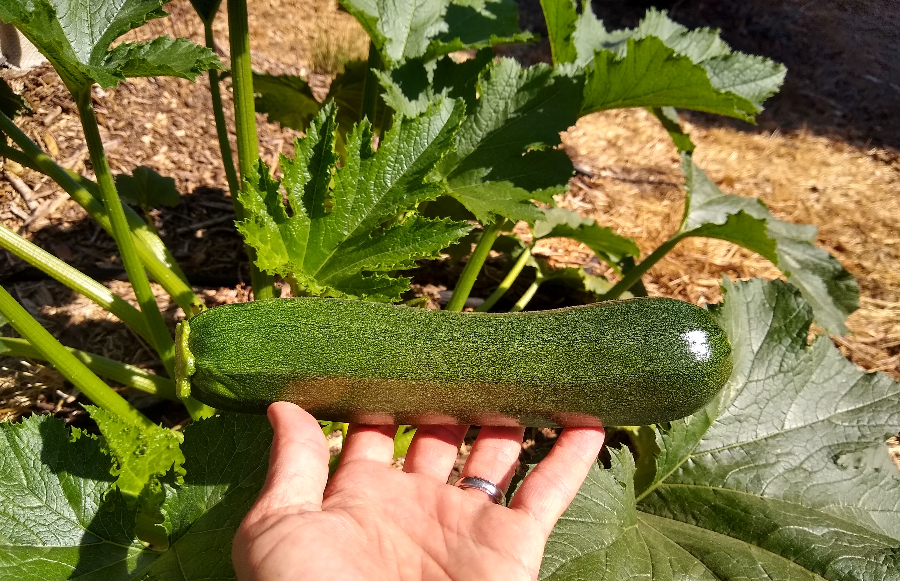
I sometimes grow two or three zucchini plants per year, replacing early plants if they become unhealthy. But I never grow more than one at a time. I can’t see how a family, let alone an individual, would need more zucchini than one plant will provide.
Zucchini plants get bigger than most other vegetables, about five feet wide, so you must allow for that much garden space.
Planting location and root knot nematodes
In part, it is because of this spacing need that I often place my zucchini plants among my fruit trees rather than within my vegetable beds. I just make sure to place them south of trees so that they get full sun, all day long, which they love.
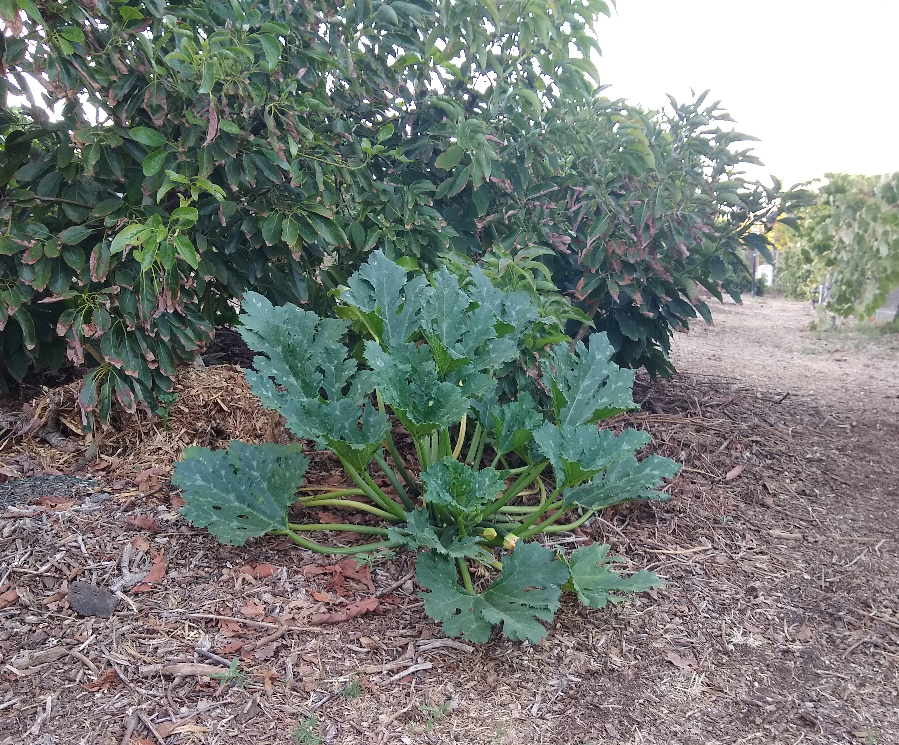
The roots of zucchini plants are hospitable to root knot nematodes. Because I have these tiny pests in my garden dirt, I have to plant zucchini where I haven’t grown it or another plant that hosts RKN for at least a year or two or else the zucchini plant will be short lived and not very productive. If you’ve had zucchini plants become unhealthy after their first few weeks in the ground, you ought to look into whether it’s because of root knot nematodes.
(See my posts, “What are root knot nematodes?” and “Dealing with root knot nematodes.”)
One way around root knot nematodes in your garden dirt is to grow in containers with a “clean” soil mix. Can you grow zucchini in a pot? Sure. You can grow anything in a pot, as long as the pot is big enough.
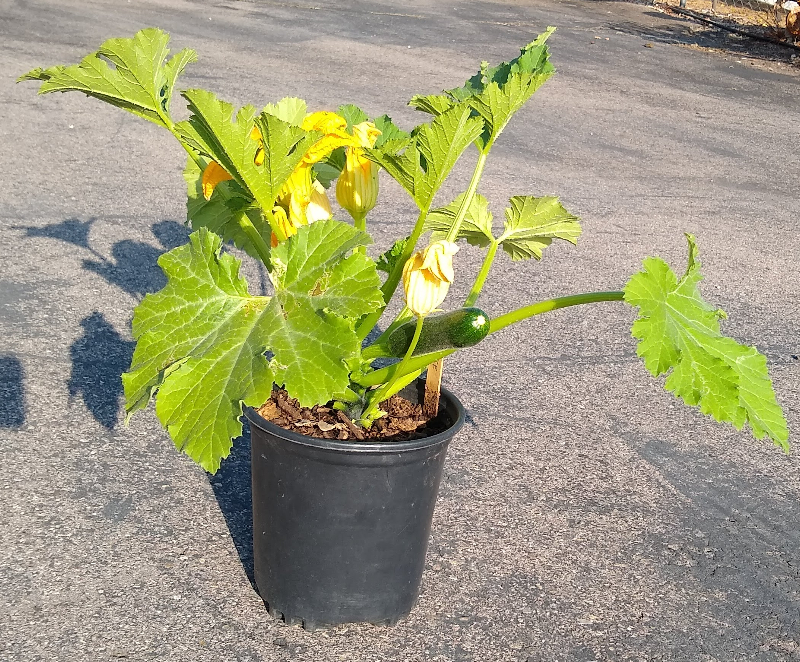
Flowering
Not every flower on a zucchini plant turns into a zucchini fruit. That’s not your fault. Some flowers are male and some are female, and only the females make fruit. (Just like humans!)
But the male flowers do have a purpose. They provide pollen for the female flowers. Here is how to distinguish between the two.
The male flowers have long, skinny stems:
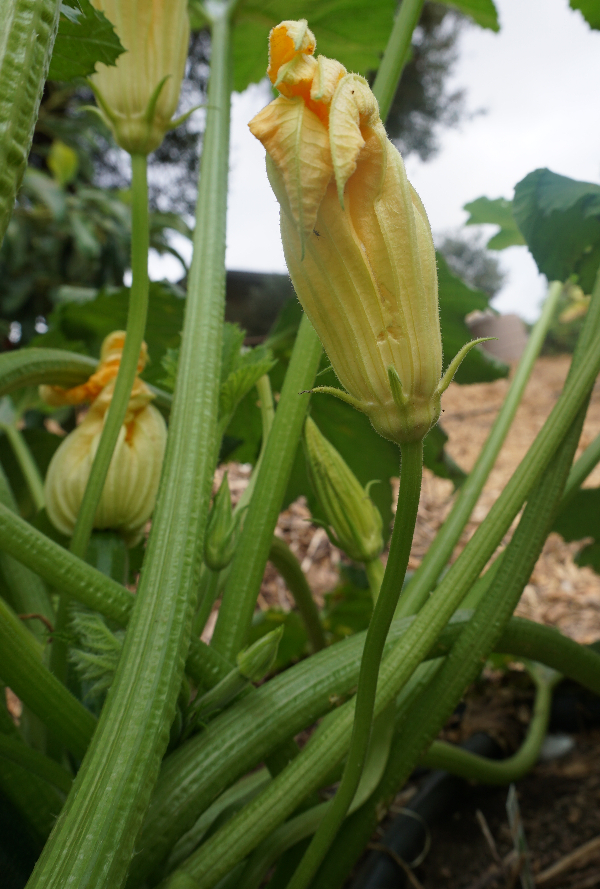
The female flowers have short, fat stems:
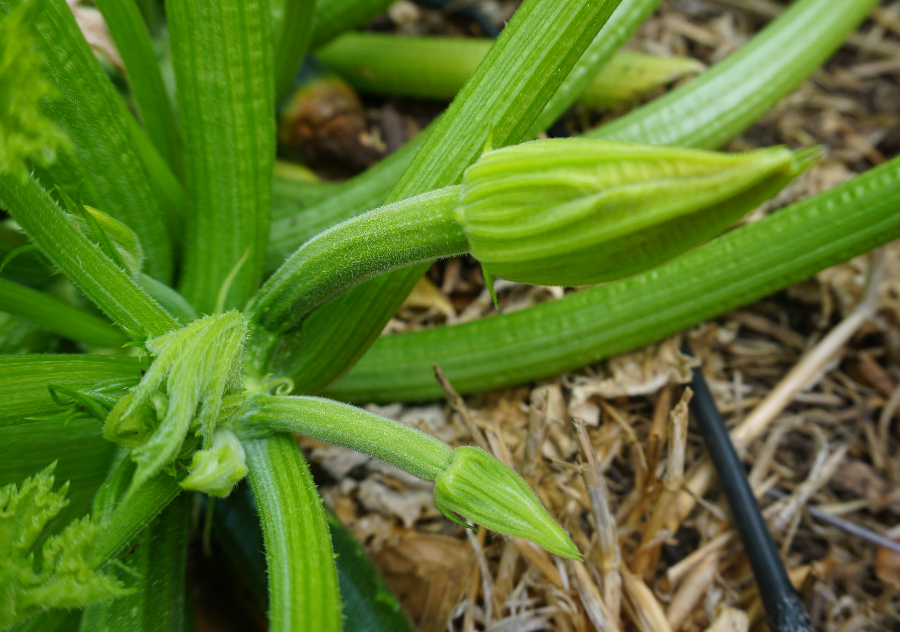
The short, fat stems on the female flowers enlarge to become the zucchini fruit.
Bees move pollen from the male flowers to the female flowers. Honey bees visit zucchini flowers but there are also native bees that visit zucchini flowers, and they’re called . . . wait for it . . . “Squash bees.”

Watering
For the last handful of years, I have watered my zucchini plants with a single drip line with emitters spaced every nine inches.
Upon planting, I use only a single emitter but then add emitters as the zucchini plant grows until it gets three emitters at mature size. The emitters I use put out 0.5 gallons per hour.
I run the drip emitters for as long as needed to give a mature zucchini plant about 10 gallons of water per week in the summer, a little more if it’s extra hot.
Fertilizing
I have never seen the need to treat soil fertility for zucchini differently than for other vegetables. So I add a couple gallons of my homemade chicken compost to the area at planting time and that’s it.
(My post on the pros and cons of fertilizing vegetables with compost.)
Harvesting
I prefer a knife with a straight (non-serrated) edge that is beveled on both sides for harvesting zucchini. Such a knife slices the stem easily and cleanly. I use my Opinel No.8.
I find that my hands and arms get more scratches from the bristly leaf stems on a zucchini plant if I harvest with pruning shears.
There’s no right or wrong as to when you harvest zucchini. Harvest at the size you like to eat. I like smaller, more tender zucchinis.
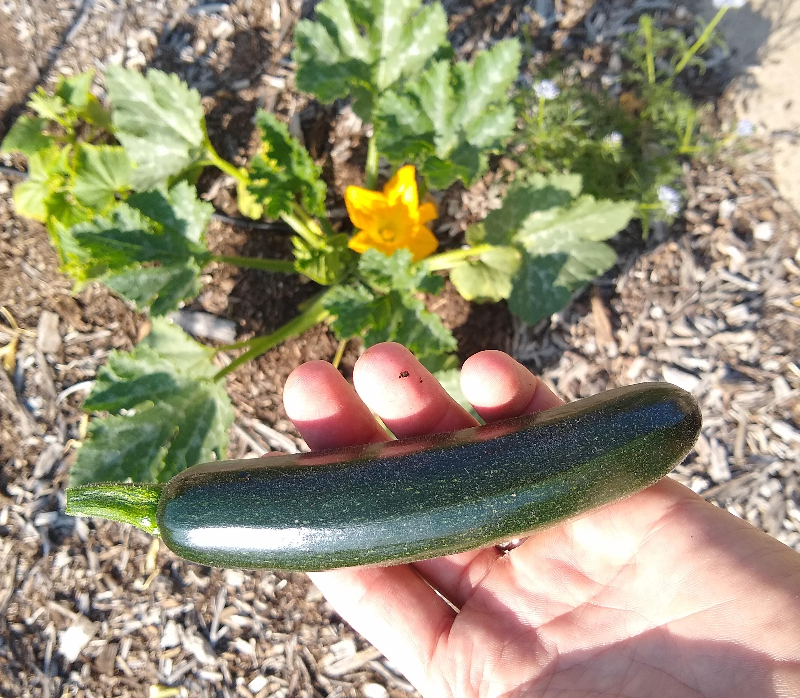
If I don’t look at the plant for a day and a fruit gets bigger than ideal, I might grate it instead of using it in slices.
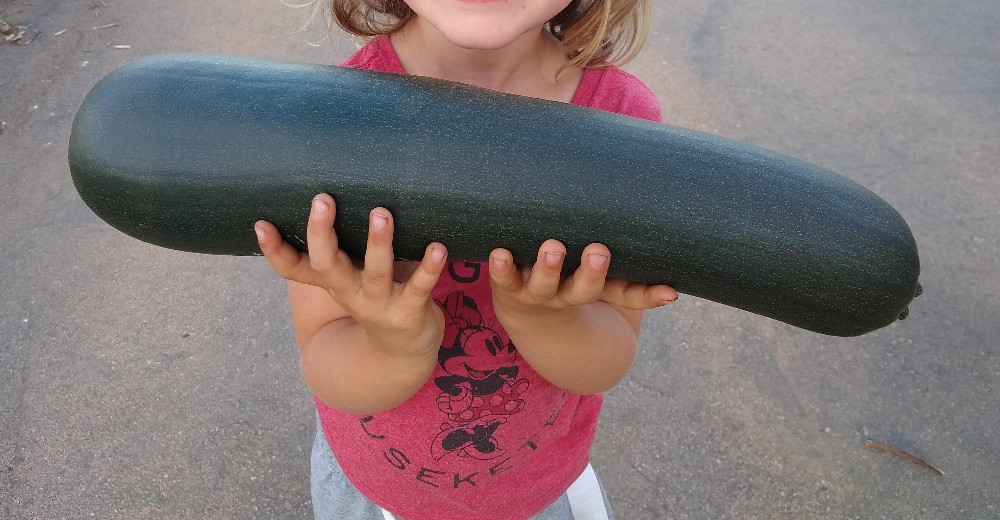
Powdery mildew
The closer you live to the beach, the more humid your air, and the more powdery mildew you will get on the leaves of your zucchini plant. That’s the white fuzzy film on top of the leaves. There’s nothing you can do to stop it. Accept it as your tax for living in such a comfortable climate.
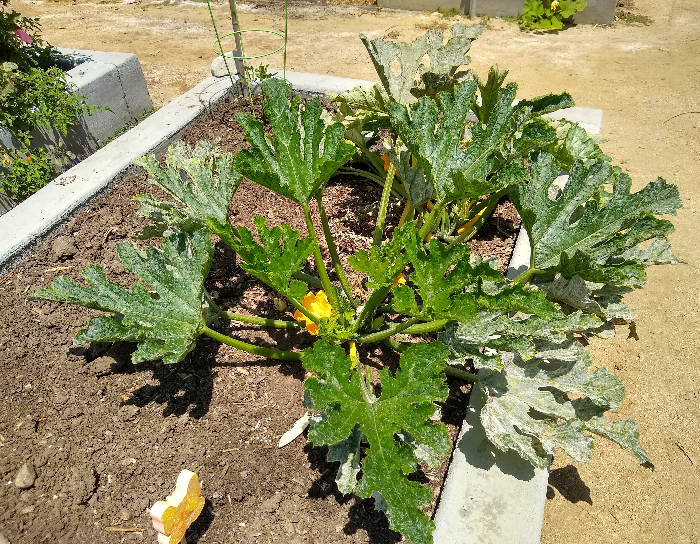
I get almost no powdery mildew on my zucchini plants these days, as I garden twenty miles inland. But I used to garden near the beach and had to tolerate more mildew. I don’t recommend wasting time and resources trying to fight it.
The old leaves on a zucchini plant that are yellowing and may have powdery mildew can be removed. Doing so may make harvesting a little easier and makes the plant look a little healthier.
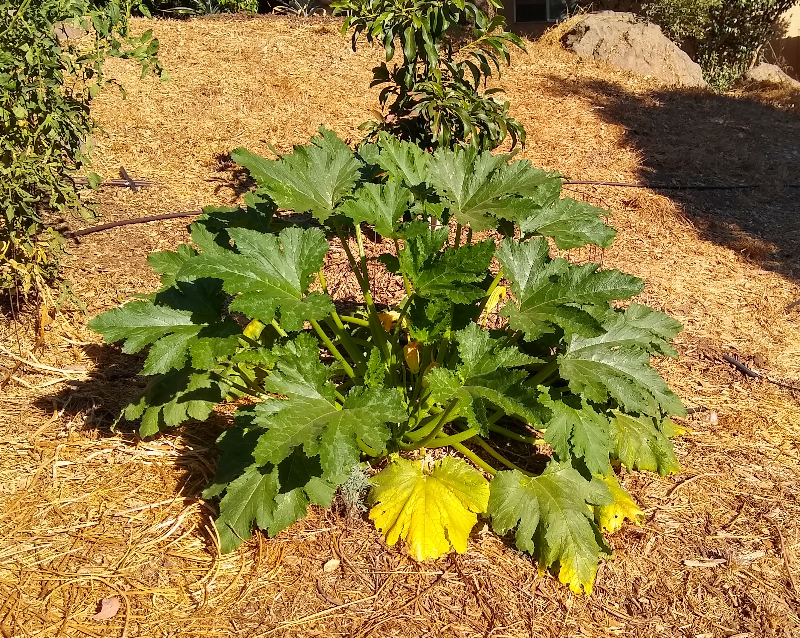

I enjoy the tropical look of a zucchini plant’s large green leaves. Reminds me of taro. And its bright orange, star-shaped flowers add to the beauty. I might even grow zucchini if it didn’t make fruit.
Thank your for supporting my Yard Posts and keeping the ads away.
All Yard Posts are listed HERE




The Lowly Zucchini: Never enough! Cream of Z soup, skin, seeds and all. Puree and freeze for a smooth soup thickener. Dehydrate round or long slices for 1/2 the lasagna pasta layers. Grate, dehydrate, then grind for Zucchini Flour. Pan sautee only the tiny ones. If they pass that stage, let em get big!
Mac Cracker: Looks like an affordable alternative to the pricey “Get Crackin” model. If you get a big crop, might want to look up Get Crackin, new or used. (Macadamia crusted zucchini!?)